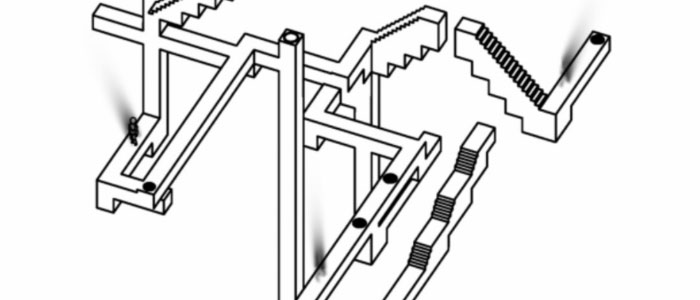Feeling overwhelmed by so-called graphics powerhouses and tired visual effects? Why not try a game that’s pure gameplay. With remarkably pared down presentation, Echochrome makes it clear from the get-go that this perception-altering game is anything but ordinary. What it lacks in chroma, the game makes up for with depth as players are asked to change reality and forge new paths by alternately eliminating and using obstacles. Didn’t pay attention to the laws of perspective in high school art class? Good, hard and fast rules involving the third dimension will only hold you back.
Echochrome uses the OLE (Object Locative Environment) Coordinate System with the goal of creating the illusion of three dimensions while an object travels on a two-dimensional plane. Against a white backdrop are a series of shapes that serve as platforms for a simple, mannequin-like figure to traverse (let’s call him Mr. Spindly). The aim is to move Mr. Spindly across the platforms to each of the echoes, and then back to his original location for the final echo. The path to puzzle solving is remarkably open-ended, as there’s no requisite order for retrieval.
In a brief tutorial the narrator introduces players to the five primary laws of Perspective Travelling, Landing, Existence, Absence and Jump. The Perspective Laws allow you to do things like connect two seemingly disparate platforms, or eliminate a pitfall simply by concealing it from view. Perhaps a bit more mind-bending are the falls and jumps, which constantly challenge perception. Ultimately, it is best not to get too caught up in wrapping your head around around things early on; the levels increase in difficulty and force you to use each law so you can catch on quickly.
The size, shape and space between platforms vary from level to level, and in combination with the pitfalls the stages become progressively more difficult. The obstacles alone force perceptual change as they often transform from pitfall to tool in quick changes between levels, whether by falling through or launching upward. The only penalty for making Mr. Spindly take a tumble is time; however it is possible to save him with quick adjustment of the platforms.
You have the option to play in Freeform, Canvas or Atelier mode. Freeform, an un-timed mode, offers a random selection, though the player is able to adjust the directional pad to indicate a difficulty setting for the puzzles chosen. Canvas mode allows you to create, try and share your own levels. With six elements available for building a stage (cubes, stairways, echoes, Mr. Spindly, and jump and pitfall blocks) the options are pretty limitless. Canvas mode is a well-thought out addition, and if your level designs leave something to be desired you can always exploit the creativity of others. However, other user-created stages are only available in the Freeform mode.
In Atelier the player can progress in any order they want, though the puzzles are sorted by difficulty. This ability to skip puzzles (also available in Freeform) is nice, though in general the rule seems to apply that if you couldn’t pass second grade you’re not ready for third. Proving just how much I like things well-ordered, Atelier was my preferred mode. The A-B-C progression is well-designed, with each level expanding on the experience of the last.
There is a pesky time limit in Atelier, and rather than a ticker on your screen remaining time is indicated by sound cues. These time restrictions really begin to hurt as you progress to more difficult puzzles where strategy takes precedence over raw experimentation. The best time is recorded for each level, and while exploration, not competition, is clearly the aim I still found myself craving the ability to see how my times compared to those of others. Handy in a tight spot is the Triangle button, which pauses Mr. Spindly on his path letting him have a good think while you sort out your next move. Lining up levels with surgical precision is a bit of a time-waster, which is where the Square button proves its worth as it triggers a snap feature. Even this option is a bit of a challenge as its functionality is spotty. The game supports SIXAXIS camera control, though there’s really no point.
A reflection of the clean elegance of the game, the violin music creates an undeniably haunting ambiance; it’s the sound of silent films that still have you shouting “Don’t open that door!” On the downside, Mr.Spindly’s footsteps seem incongruously feminine, like a secretary walking down a corridor, though I suppose Mr. Spindly could just as easily be the Missus. The decidedly female narrator, however, is just as haunting as the violin. Reminiscent of all that “The Cake is Lie” business, she sounds rather like a flight attending trying to calm passengers on a burning aircraft.
A remarkably spare looking spatial puzzle game, Echochrome delivers challenging gameplay and innovation. As a truly unique experience, Echochrome is hard not to recommend. A dash of Lemmings with a whole lot of M.C. Escher, I think the latter would be proud. Furthermore, it’s reassuring to know that the occasional developer can forsake a life of graphics whoring in favor of delivering something so gameplay-centric.
